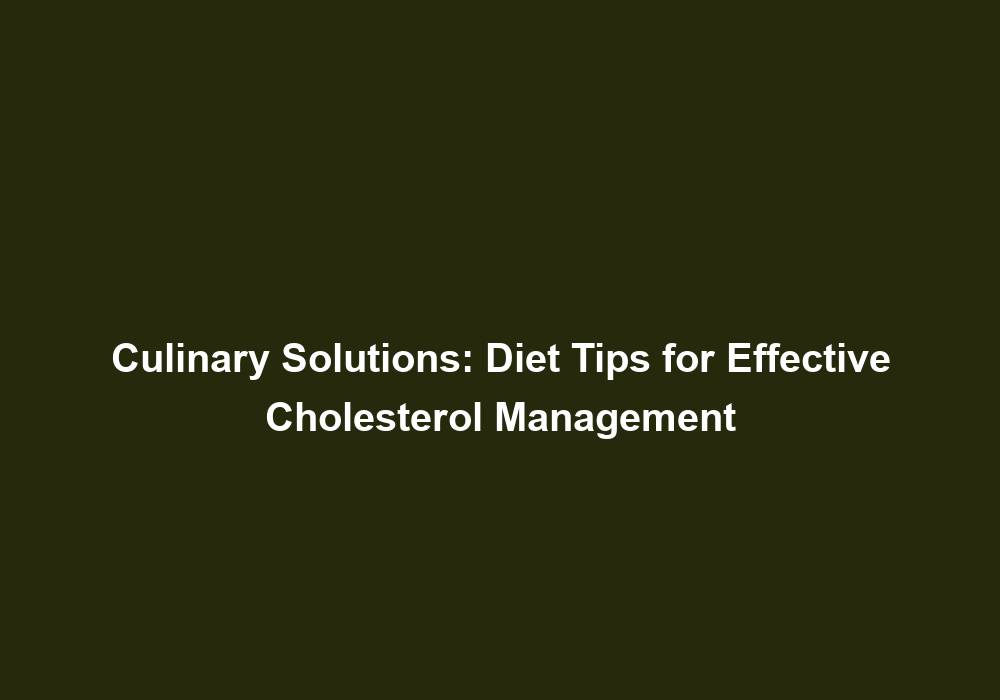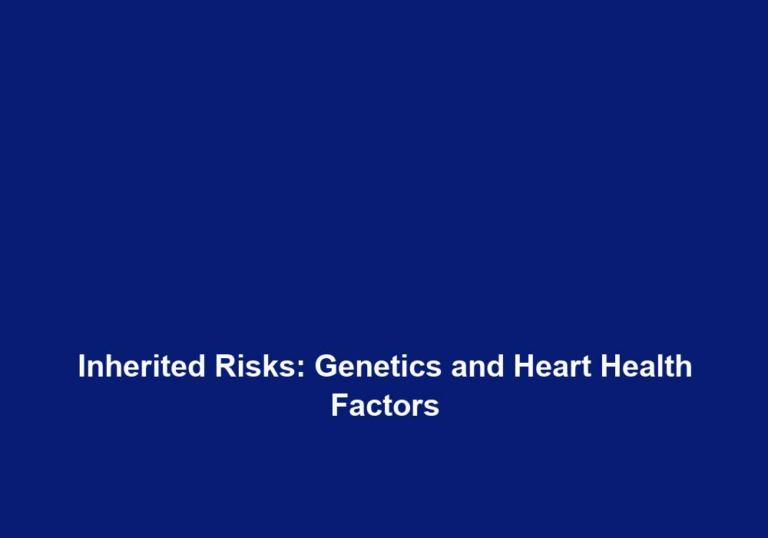Culinary Solutions: Diet Tips for Effective Cholesterol Management
Maintaining healthy cholesterol levels is crucial for overall well-being, as high cholesterol levels can increase the risk of heart disease and other cardiovascular issues. While medication plays a vital role in managing cholesterol, adopting a healthy diet is equally important. By making smart food choices and incorporating certain culinary solutions into your daily routine, you can effectively manage your cholesterol levels. In this article, we will explore some valuable diet tips that can help you achieve optimal cholesterol levels and promote a healthier lifestyle.
Understanding Cholesterol
Before diving into the dietary tips, it’s essential to understand what cholesterol is and how it affects our bodies. Cholesterol is a waxy substance produced by the liver and can also be found in certain foods. It plays a crucial role in the production of hormones, vitamin D, and substances that aid in digestion. However, high levels of low-density lipoprotein (LDL) cholesterol, also known as bad cholesterol, can accumulate in the arteries, leading to plaque formation and potential blockages. On the other hand, high-density lipoprotein (HDL) cholesterol, often referred to as good cholesterol, helps remove LDL cholesterol from the arteries.
Cholesterol is a complex topic, and it’s important to have a clear understanding of the different types and their effects on the body. LDL cholesterol is considered bad because it can build up in the arteries, causing blockages and increasing the risk of heart disease. HDL cholesterol, on the other hand, is beneficial as it helps remove LDL cholesterol from the arteries, reducing the risk of plaque formation. By understanding the role of cholesterol in the body, you can make informed decisions about your diet and lifestyle to effectively manage your cholesterol levels.
The Role of Diet in Cholesterol Management
-
Choose Healthy Fats
Incorporating healthy fats into your diet is essential for managing cholesterol levels. Opt for unsaturated fats found in foods like avocados, nuts, seeds, and olive oil. These fats have been shown to raise HDL cholesterol levels while lowering LDL cholesterol. Additionally, they provide essential fatty acids that support overall health. Including these healthy fats in your meals can help improve your cholesterol profile and promote heart health.
- Avocados: Avocados are a great source of monounsaturated fats, which can help lower LDL cholesterol levels. They are also packed with fiber, vitamins, and minerals, making them a nutritious addition to your diet.
- Nuts and Seeds: Almonds, walnuts, chia seeds, and flaxseeds are rich in omega-3 fatty acids, which have been shown to reduce LDL cholesterol levels. They are also high in fiber and other nutrients that support heart health.
- Olive Oil: Olive oil is a healthy alternative to saturated fats and can be used in cooking and as a salad dressing. It contains monounsaturated fats that can help raise HDL cholesterol levels and lower LDL cholesterol levels.
-
Consuming an adequate amount of dietary fiber can help lower cholesterol levels. Soluble fiber, in particular, has been proven to reduce LDL cholesterol. Foods rich in soluble fiber include oats, barley, legumes, fruits, and vegetables. Aim for at least 25-30 grams of fiber per day.
- Oats: Oats are a great source of soluble fiber, specifically beta-glucan, which has been shown to reduce LDL cholesterol levels. Start your day with a bowl of oatmeal or incorporate oats into baked goods and smoothies for an added fiber boost.
- Barley: Barley is another grain rich in soluble fiber that can help lower cholesterol. It can be used in soups, stews, or as a side dish to increase your fiber intake.
- Legumes: Beans, lentils, and chickpeas are high in soluble fiber and can be added to salads, soups, or main dishes to boost your fiber intake. They are also a good source of plant-based protein, making them an excellent choice for vegetarians and vegans.
- Fruits and Vegetables: Most fruits and vegetables are high in fiber, especially when consumed with their skins. Berries, apples, pears, broccoli, Brussels sprouts, and carrots are examples of fiber-rich produce that can help lower cholesterol levels.
-
Consume Omega-3 Fatty Acids
Omega-3 fatty acids have numerous health benefits, including reducing LDL cholesterol levels. Add sources of omega-3 fatty acids to your diet, such as fatty fish (salmon, mackerel, sardines), flaxseeds, chia seeds, and walnuts.
- Fatty Fish: Fatty fish like salmon, mackerel, and sardines are excellent sources of omega-3 fatty acids. Aim to include these fish in your diet at least twice a week to reap the cholesterol-lowering benefits.
- Flaxseeds and Chia Seeds: Flaxseeds and chia seeds are rich in alpha-linolenic acid (ALA), a type of omega-3 fatty acid. Ground flaxseeds can be added to smoothies, yogurt, or baked goods, while chia seeds can be sprinkled on top of salads, oatmeal, or mixed into puddings.
- Walnuts: Walnuts are not only a great source of omega-3 fatty acids but also provide fiber and other heart-healthy nutrients. Snack on a handful of walnuts or add them to salads and baked goods for a nutritious boost.
-
Include Plant Sterols and Stanols
Plant sterols and stanols are naturally occurring substances found in plants that can help lower LDL cholesterol levels. Foods fortified with plant sterols and stanols, such as certain margarines, can be beneficial in cholesterol management.
- Margarines: Look for margarines fortified with plant sterols or stanols, as they have been shown to reduce LDL cholesterol levels when consumed as part of a healthy diet. These products are often labeled as “cholesterol-lowering” or “heart-healthy.”
-
Limit Saturated and Trans Fats
Saturated and trans fats raise LDL cholesterol levels, increasing the risk of heart disease. Limit the consumption of foods high in saturated fats like fatty meats, full-fat dairy products, and fried foods. Additionally, avoid trans fats found in processed snacks, commercially baked goods, and fast food.
- Fatty Meats: Choose lean cuts of meat and trim any visible fat before cooking. Opt for chicken or turkey without the skin, and include plant-based protein sources like legumes and tofu in your meals.
- Full-Fat Dairy Products: Switch to low-fat or non-fat dairy products such as skim milk, low-fat yogurt, and reduced-fat cheese. These options provide the same nutrients with less saturated fat.
- Fried Foods: Limit your intake of fried foods, as they are often cooked in unhealthy oils that are high in saturated or trans fats. Instead, opt for baked, grilled, or steamed preparations.
-
Increase Consumption of Fruits and Vegetables
Fruits and vegetables are rich in vitamins, minerals, and antioxidants, making them an essential part of a heart-healthy diet. They are also high in fiber, helping to lower cholesterol levels. Aim for a variety of colorful produce to obtain a wide range of nutrients.
- Variety is Key: Include a variety of fruits and vegetables in your diet to ensure you receive a wide range of nutrients. Different colors represent different types of antioxidants and phytochemicals, which have various health benefits.
- Fresh or Frozen: Both fresh and frozen fruits and vegetables are nutritious choices. If fresh produce is not available, frozen options can be just as healthy as they are often picked at the peak of ripeness and retain their nutrient content.
-
Include Whole Grains
Whole grains, such as whole wheat, brown rice, quinoa, and oats, contain high amounts of fiber and nutrients. They can help lower LDL cholesterol levels and reduce the risk of heart disease. Replace refined grains with whole grains whenever possible.
- Whole Wheat: Opt for whole wheat bread, pasta, and flour instead of refined grains. Whole wheat contains all parts of the grain, including the bran, germ, and endosperm, providing more fiber and nutrients.
- Brown Rice: Replace white rice with brown rice, as it is a whole grain that retains its fiber content. Brown rice can be used as a side dish, in stir-fries, or as a base for grain bowls.
- Quinoa: Quinoa is a complete protein and a good source of fiber. It can be used as a substitute for rice or pasta, added to salads, or used as a stuffing for vegetables.
- Oats: Incorporate oats into your diet by enjoying a bowl of oatmeal for breakfast or using oats in baking recipes. Oats are high in soluble fiber, which can help lower cholesterol levels.
-
Opt for lean protein sources to reduce saturated fat intake. Good options include skinless poultry, fish, legumes, tofu, and low-fat dairy products. Incorporate these protein sources into your meals to maintain a balanced diet.
- Skinless Poultry: Choose skinless chicken or turkey breast, as they are lower in saturated fat compared to poultry with the skin. These lean protein sources can be grilled, baked, or sautéed for a healthy and delicious meal.
- Fish: Fish, such as salmon, trout, and tuna, are not only excellent sources of lean protein but also provide omega-3 fatty acids. Aim to include fish in your diet at least twice a week for optimal heart health.
- Legumes: Legumes, including beans, lentils, and chickpeas, are rich in protein and fiber. They can be used as a meat substitute in various dishes or added to salads and soups.
- Tofu: Tofu is a versatile plant-based protein source that can be used in stir-fries, salads, and sandwiches. It is low in saturated fat and cholesterol, making it a heart-healthy option.
- Low-Fat Dairy Products: Choose low-fat or non-fat dairy products like milk, yogurt, and cheese to reduce saturated fat intake while still obtaining essential nutrients like calcium and protein.
-
Moderate Alcohol Consumption
Excessive alcohol consumption can lead to various health problems, including high cholesterol levels. If you choose to drink alcohol, do so in moderation. For men, it’s recommended to have no more than two drinks per day, while women should limit it to one drink.
- Moderation is Key: If you enjoy drinking alcohol, it’s important to do so in moderation. Limit your intake to the recommended guidelines to avoid negative health effects.
- Know Your Limits: Be aware of the standard drink sizes and measure your alcohol consumption accordingly. One drink is typically defined as 14 grams of pure alcohol, which is equivalent to 1.5 ounces of distilled spirits, 5 ounces of wine, or 12 ounces of beer.
-
Stay Hydrated
Drinking an adequate amount of water is essential for overall health. It helps in maintaining proper bodily functions, including cholesterol metabolism. Aim to drink at least 8 cups of water per day.
- Water is Vital: Water is the best choice for hydration as it contains no calories, sugar, or additives. It helps flush out toxins, supports digestion, and aids in maintaining optimal cholesterol levels.
- Hydration Tips: Carry a reusable water bottle with you throughout the day to remind yourself to drink water. Set reminders on your phone or use apps to track and monitor your water intake.
Conclusion
Managing cholesterol levels is a critical aspect of maintaining good heart health. By incorporating these diet tips into your daily routine, you can effectively manage your cholesterol levels and reduce the risk of heart disease. Remember to choose healthy fats, increase fiber intake, consume omega-3 fatty acids, limit saturated and trans fats, and include plant sterols and stanols. Additionally, prioritize fruits, vegetables, whole grains, and lean protein sources while moderating alcohol consumption and staying hydrated. By making these culinary solutions a part of your lifestyle, you can embark on a journey towards effective cholesterol management and overall well-being.
Please note that these dietary tips are general recommendations and may not be suitable for everyone. It is always advisable to consult with a healthcare professional or a registered dietitian before making significant changes to your diet.







